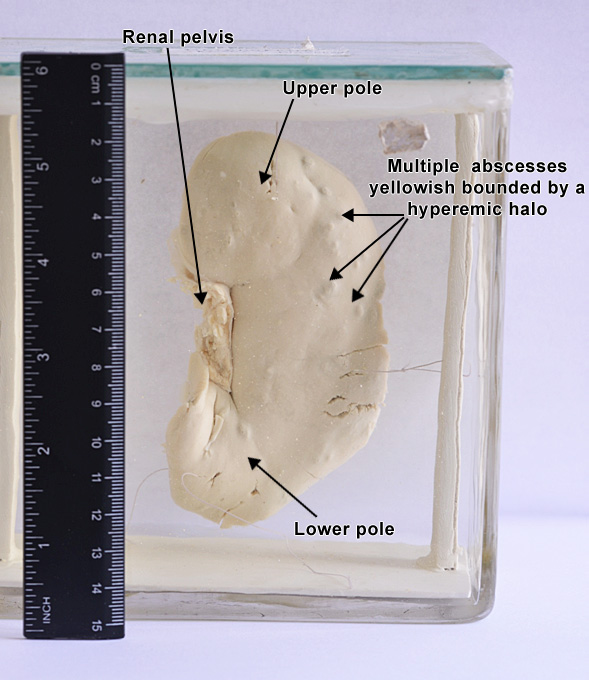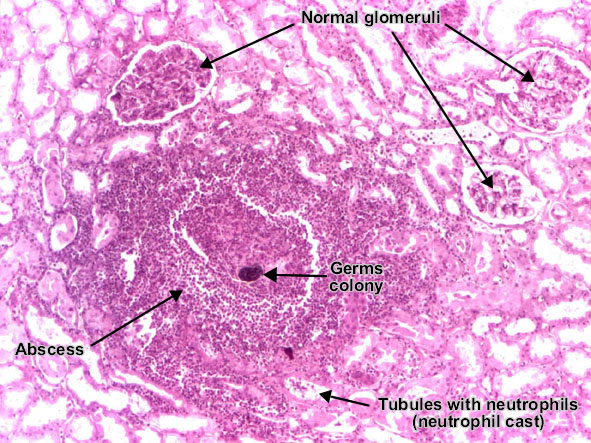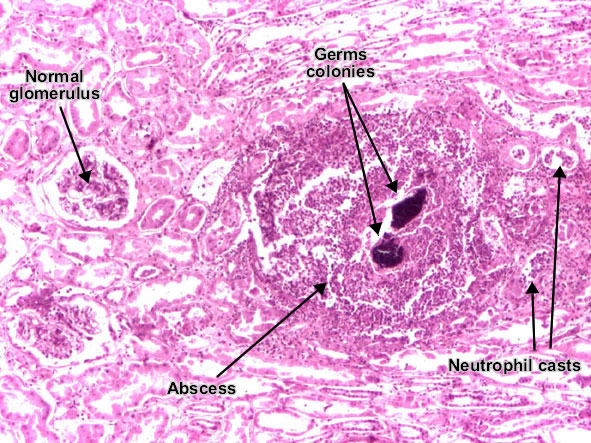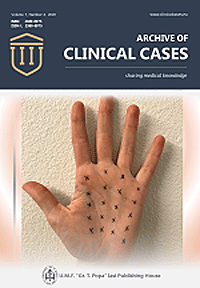Acute pyelonephritis
Acute pyelonephritis is an acute suppurative inflammation of the kidney caused by bacterial infections (Escherichia coli in 70 - 80 % of cases, Proteus mirabilis, Klebsiella pneumoniae, Enterococus fecalis, Staphylococcus).
Routes of infection :
Ascending infection (the most frequent). In most cases, the infection begins in the lower urinary tract (cystitis, urethritis) and ascends to pelvis and renal parenchyma.
Predisposing factors :
- Urinary tract obstruction, congenital or acquired (renal lithiasis)
- Catheterization of the urinary tract, cystoscopy
- Vesicoureteral reflux, incompetence of vesicoureteral junction
- Pregnancy
- Gender and age, young women are more affected than men in a ratio of 6:1
- Preexisting renal lesion
- Diabetes mellitus
- Immunosuppression and immunodeficiency
Hematogenous infection. Infection spreads through the blood-stream from distant foci (bronchopneumonia, otitis, endocarditis or septicemia) causing abscesses. This form is found especially in newborns or immunodeficiency people.
Complications of acute pyelonephritis :
- Papillary necrosis - frequently seen in diabetics and those with urinary obstruction
- Pyonephrosis
- Perinephric abscess
Macroscopy :
The size of the affected kidneys is normal or slighted enlarged.
In the hematogenous pathway of infection, on the cut surface, multiple isolated pale-yellowish abscesses (1 - 5 mm in diameter) with a hyperemic halo can be seen, especially in the cortical area and on the external surface of the kidney (Figure 1). Mucosa of renal pelvis and calyx is congestive and covered by a purulent exudate. In severe cases, areas of confluent suppuration can be seen around the renal pyramids.

Figure 1. Acute pyelonephritis: kidney abscesses
In the ascending pathway of infection, the pielo-caliceal mucosa presents purulent exudate and the abscesses have a radial distribution, from calices to renal cortex.
Microscopy
The renal interstitium presents abscesses (suppurative necrosis), consisting of purulent exudate (pus) : neutrophils, fibrin, cell debris and central germ colonies (hematoxylinophils). Tubules are damaged by exudate and may contain neutrophil casts, which can be found in urine. In the early stages, glomeruli and vessels are spared. (Figures 2 and 3)


Figures 2 and 3. Acute pyelonephritis : kidney abscesses (Hematoxylin-eosine, ob. x10)
Additional information :

